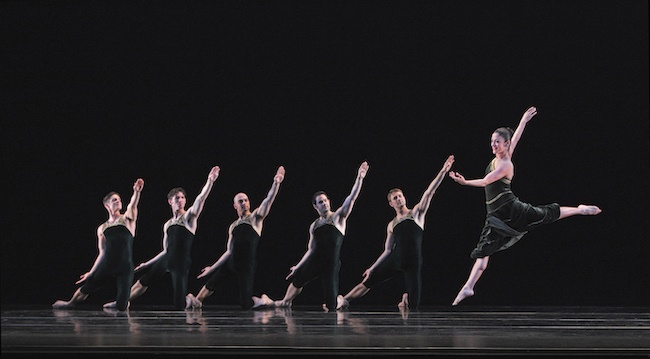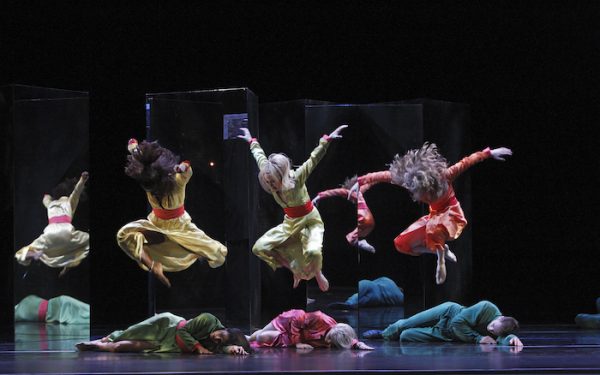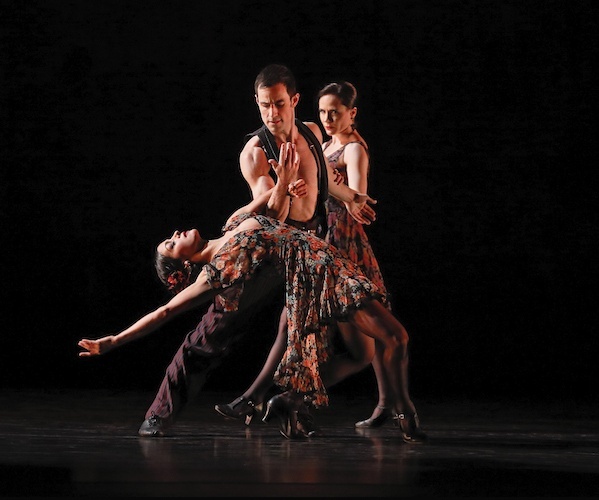Dance Commentary: Paul Taylor — Now You See It, Virtually
By Marcia B. Siegel
I’ve always believed that dance has a literature, much like music or drama. Dance’s literature consists of both ideas (choreography) and the execution of ideas (performance).

The Paul Taylor Dance Company in a scene from The Brandenburgs. Photo: Paul B Goode.
Paul Taylor was one of many dancers who distrusted filmed versions of their dances. He was also one of the many who allowed his dances to be filmed. I knew all three of the works that we missed when the Celebrity Series canceled the spring season dates for the Paul Taylor Dance Company. I was sorry to miss a performance that could have given a small survey of Taylor’s choreographic range, but I knew I could revisit the three dances on my own. I’d been looking forward to the Taylor company’s first appearance in Boston since 2013. I did see the company once or twice in New York after they assumed a formidable new identity as “Paul Taylor American Modern Dance” and moved their annual season to Lincoln Center. But I haven’t seen them since the artistic directorship passed to Michael Novak in 2018, after Taylor died.
To cope with the effects of the virus shutdown, the Taylor company has joined the rest of the dance world and put up a big presence online: classes, talk, and videos. They don’t make it easy to access their archives, or even to learn what videos have been made, but as far as I can determine there were at least 10 professionally made films of complete dances and three important documentaries. You aren’t meant to look at them for entertainment, or for any other reason, unless sanctioned by the company. There are also several Taylor dances you can access on Vimeo, YouTube, and Amazon.
By now, no one thinks a dance film is a dance, but film is a great asset to dance watchers. You can screen a dance to experience its pleasures again in memory, or look at a dance for the first time to discover what makes it noteworthy. Dancers usually talk about their work in terms of movement; audiences, seized by the visceral effects of performance, buy into the idea that it’s the moves that constitute the dance. This notion leaves out the creative artifact, the way the movement was made into a performed entity — or, how the ingredients were cooked up into that particular dish.
I’ve always believed that dance has a literature, much like music or drama. Dance’s literature consists of both ideas (choreography) and the execution of ideas (performance). As a writer I realize you can’t capture all this in words. But I do try to understand what constitutes any choreography, and I believe that a choreographic work is as much a creative achievement as a song or a symphony. Along with that act of recognition comes the need to study the work — and that means having access to films, recorded versions of it that can be looked at repeatedly.
Paul Taylor was a classicist, despite his modern dance roots and his personal eccentricities. Brandenburgs (1988)* is only one of several “pure dance” dances he made, and one of at least five works where he used Bach’s music. Based on two of the Brandenburg Concertos, it’s set almost entirely in counterpoint. The cast is sorted into two basic units (a trio of three women with their male partner, and a corps of four men), which work in opposing but complimentary units. The scale is reduced at times — each woman gets a solo of her own and their escort has a long solo. In an allegro finale, the groups assemble and regroup in different ways, led by one of the solo dancers.
This balletic way of organizing a dance can be satisfying, intriguing. George Balanchine comes to mind, not only because the three-women versus one-man group recalls his Apollo. On a DVD recorded in Paris in 2012 Taylor comments, “It has a theme, of gallantry toward women.” Taylor is known to have offered different explanations for his work when pressed; that remark could be one day’s offhand observation. The “Apollo” analogy was frequently mentioned by critics, but it’s only one factor in a bigger compositional scheme and, in fact, the male dancer isn’t the instigator, as he is in the original Apollo. Taylor’s women spark off the trio’s action most of the time. Looking at Brandenburgs now, I’m thinking maybe the whole dance overturns the tradition “male = escort/female = follower” and “corps de ballet must be female.” Without abandoning formal composition, Taylor turned balletic roles inside out.

A scene from the Paul Taylor Dance Company’s Last Look. Photo: Paul B Goode.
Paul Taylor was a contrarian. He always seemed to be seeking an untenable balance between order and chaos. If Brandenburgs is an idealized universe of differing parts, Last Look (1985) could be an ultimate descent into madness. With Donald York’s score, a takeoff on the doom-laden waltzes of Maurice Ravel, the dance exposes a collection of tortured beings. It takes place in a borderless space splintered by mirrors. Especially in the film version directed by Thomas Grimm (designer Alex Katz, lighting by Jennifer Tipton), you can’t tell where the mirrors are in the space, or exactly what size and shape they are. If you could, the inmates would be able to find an escape route.
Dimly, after a period of darkness, you can make out a large blob, amorphous like the rest of the scene. The shape turns out to be the bodies of people piled on top of each other at random. They begin to crawl out of the pile and, as the lights come up, you see a scramble of colors: acid pinks, greens and yellows of the satin bathrobes worn by women and the men’s dark green uniforms. It’s hard even then to determine how many people there are. When they lurch into action we could be looking at a psych ward, its disturbed tenants running, hurtling, falling, grasping, clutching, straining, jiggling, smashing, colliding, trying to harm themselves and each other but repelling the contact. Finally they subside back into their pileup, where anonymity seems the only way to survive.
Besides his classical pieces and neurotic indulgences, Paul Taylor could make satires, stories, and dances for pure entertainment. He’d invented a basic movement vocabulary that he could strategically adapt for all his dances. With his dancers, designers, and musical companions he wrought a lifetime of diverse creations. Piazzolla Caldera (1998) drew on the infectious rhythms of Astor Piazzolla for a takeoff on the tango.

The Paul Taylor Dance Company in a scene from Piazzolla Caldera. Photo: Paul B Goode.
Unlike the Brandenburgs and Last Look, Piazzolla is a suite of dances based on unrelated selections of music. Without following a preconceived musical or dramatic line, the choreographer can reflect on any idea he desires. Taylor made many suite dances throughout his life: comedies (Piece Period, 1962), menageries (Book of Beasts, 1971), culture clashes (Cloven Kingdom, 1976), and satires (Company B, 1991).
There’s no publicly available video of Piazzolla, but Matthew Diamond’s intimate documentary “Paul Taylor Dancemaker”** visits the process of creating it, culminating in its New York premiere. I saw it on stage a few times and wrote it off as the kind of crowd-pleaser Taylor could make so successfully, a quasi-tango dance, possibly bogus. Strutting and seducing in their filmy dresses and thigh-rolled stockings, their overdeveloped pecs and biceps, the women and men stalk each other, lock together, separate. Diamond filmed it in dizzying glances from different angles, as if the camera itself was being swept into the passion.
Taylor makes various comments throughout the film about what he’s doing, not that he knows what he’s doing until it’s done. About Piazzolla, he says in a voiceover: “The dance is not about love as such. It’s about physical sex. And those relationships which we make do for love. Sometimes.” When someone off camera asks him a leading question, he responds: “I don’t really have a message. But I watch people. . . . I have no moral attitude really. I’m a reporter. I report things as I see them.”
* Brandenburgs — With Beloved Renegade (2008), on the DVD Paul Taylor Dance Company in Paris, released by Bel Air Classiques. Available on Amazon.
** Dancemaker can be seen on YouTube or at the Taylor company website (ptamd.org/digital) — scroll down to “Free Streaming Video.” This video is also available on Amazon.
Internationally known writer, lecturer, and teacher Marcia B. Siegel covered dance for 16 years at the Boston Phoenix. She is a contributing editor for the Hudson Review. The fourth collection of Siegel’s reviews and essays, Mirrors and Scrims—The Life and Afterlife of Ballet, won the 2010 Selma Jeanne Cohen prize from the American Society for Aesthetics. Her other books include studies of Twyla Tharp, Doris Humphrey, and American choreography. From 1983 to 1996, Siegel was a member of the resident faculty of the Department of Performance Studies, Tisch School of the Arts, New York University. She has contributed two selections to Dance in America, the latest edition in the Library of America’s “Reader’s Anthology” series. Her 2006 book, Howling Near Heaven – Twyla Tharp and the Reinvention of Modern Dance, has been reissued in paperback with a new introduction, by the University Press of Florida.
